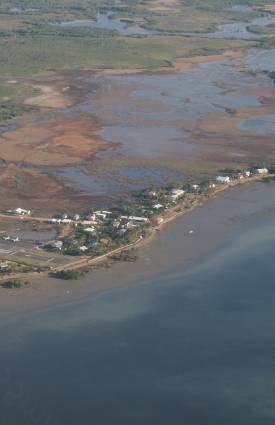

Climate adaptation
Human rights vacuum

International human rights vacuum
Currently no international convention covers the protection of people displaced by climate change or other environmental impacts.
Legal recognition and protection rights for people seeking
refuge due to political or religious persecution grew out of the
experience of the Jews and others who fled their countries as a
result of persecution in WWII.
This led to the 1951 UN Refugee Convention Relating to the Status
of Refugees, which was followed by the 1967 Protocol Relating to
the Status of Refugees which extended protection to 'refugees'
worldwide by removing specific references to WWI.
The obligation to grant refugee status to those who qualify under
the Convention only applies the many countries that have formally
adopted and ratified the 1951 Convention and 1967 Protocol.
Australia, along with many other countries, has done
this.
The 1951 Convention does cover environmental reasons for
displacement.
Why 'refugee' is a sensitive term
You might notice that Green Cross does not use the term 'refugee' when discussing the plight of people displaced by sea level rise and climate change impacts.
This is because the word has become a hot potato. Unprecedented numbers of people are being forced from their homes for all kinds of reasons and many millions applying for recognition as refugees, and this is creating political pressure for some governments, who are beginning to call for the Refugee Convention to be overhauled.
Critics of the Refugee Conventions say it is no longer relevant to the world we live in where mass migrations occur much more often than in the post-war environment due to drought/famine and oppressive regimes. Darfur in the Sudan and Zimbabwe are cases in point. They also claim the Convention has inconsistent interpretation, and fails altogether when it comes to internally displaced people in need that do not cross national borders.
Refugee advocates say the Convention must continue as the cornerstone for determining refugee status because without it human rights would be seriously eroded. These advocates fear that a restructure of the Convention could provide countries with an opportunity to opt out altogether, leaving many millions of people seeking refuge completely vulnerable. They acknowledge that internally displaced people need new types of protection schemes but urge global leaders 'not to throw out the baby with the bathwater'.
The tension between the rights of nation states and universal human
rights is at an all time high, and that's why many commentators are
vigilant in guarding the use of the word 'refugee' so that it does
not become devalued.
Our aim is to create an informed debate about the impact of sea level rise so that Australia can play a leadership role in seeking solutions. That may mean entirely new opportunities for leadership in our region, depending on how the Citizens' Panel reaches its consensus recommendations.
Because of these sensitivities Green Cross is sticking to terms such as 'victims of sea level rise' and 'people displaced due to climate change'.
To read more about this please see the background paper written by Sonia Caton.
Copyright © Green Cross Australia | Terms & Conditions | Privacy Policy
web design brisbane :: (zero)seven
